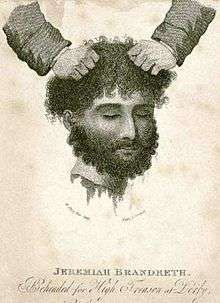Jeremiah Brandreth
| Jeremiah Brandreth | |
|---|---|
|
Contemporary image | |
| Born |
1785 Holborn |
| Died |
7 November 1817 Derby |
| Education | Bluecoat School, Barnstaple, Devon |
| Occupation | Stocking maker |
| Spouse(s) | Ann Bridget, Sutton - in - Ashfield, September 29th 1811 |
| Children | Three |
| Parent(s) | Timothy Brandreth & Mary Smollett |
Jeremiah Brandreth (1785 – 7 November 1817) was an out-of-work stocking maker who lived in Sutton-in-Ashfield, Nottinghamshire, who was beheaded for treason. He was known as "The Nottingham Captain". He and two of his conspirators were the last people to be beheaded with an axe in Britain.[1]
The plot
Brandreth was born in Holborn, London and was baptised at St Andrews Holborn on June 26th 1785. The Brandreth family moved to Barnstaple, Devon, in 1786.When he was about 13 the family moved to Exeter and set up a framework knitting business on Maudlin Street. In 1803 he was listed as a reservist in the 28th Regiment of foot and in the same year was present at the execution of Colonel Despard and six guardsmen in London. He deserted from the army around 1808. In 1809 and 1811 his mother and then his father died. He moved to Sutton-in-Ashfield, where he had a wife and three children.[5] The Life of Jeremiah Brandreth by John Dring copyright Pentrich & South Wingfield Revolution Group.
It is believed that Brandreth was involved in Luddite activities in 1811. He was involved in a Luddite raid in 1811 when a fellow Luddite was shot dead.
He met William J. Oliver ("Oliver the Spy") in May 1817 and agreed to cooperate in a plan where he would join 50,000 men in London to storm the Tower. It is widely believed that Brandreth was a victim of the then Home Secretary, Lord Sidmouth, who took severe measures against Luddite rioters.[2] The "revolution" began on 9 June 1817. Brandreth had held a final meeting at a pub in Pentridge, or Pentrich, The White Horse, where he and his fellow conspirators were to lead a march on Nottingham where "they would receive 100 guineas, bread, meat and ale." They would then lead an attack on the local barracks, overthrow the government and end "poverty for ever".
They met soldiers in Giltbrook, near the town of Eastwood in Nottinghamshire.
The trial
Thirty-five people were brought to trial and Brandreth and two others, William Turner and Isaac Ludlam, were sentenced to be hanged, drawn and quartered, but the sentence of quartering was commuted by the Prince Regent.
On the scaffold one of the men claimed that they had been set up by Lord Sidmouth and "Oliver the spy". This was investigated by Edward Baines of the Leeds Mercury and sufficient evidence was found to enable publication. Brandreth was hanged however and once dead, he and the other two had their heads cut off with an axe.[1] It has been said by Ivor Smallen that the crowd did not cheer as expected when Brandreth's head was shown to the crowd as a traitor. Cavalrymen were said to be getting ready to charge.
The board that was used to hold the bodies during the beheading is kept in Derby Museum.
References
- 1 2 Hanging, Drawing and Quartering at the Wayback Machine (archived October 4, 2006) accessed July 2007.
- ↑ Chambers Biographical Dictionary (1990). p. 1346.
- ↑ Derby Gaols Hangings, 1732 to 1847. Derby Reporter, 2 April 1847.
External links
- Pentrich Historical Society website accessed July 2007
- Gyles Brandreth claims to be related accessed July 2007
- Oliver the Spy by Michael Parkin, 2016`
